 She was the original funny girl but her life was not all laughs. 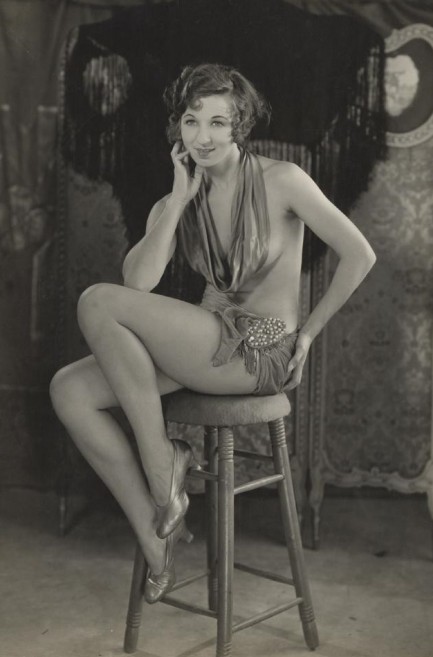
U.S. born Fanny Brice, née Fania Borach, was a theater, radio, and film actress mainly remembered today as the creator and star of the radio comedy series The Baby Snooks Show. For a time she was one of the most popular performers in America. What makes Brice pulp worthy? She fell in love with her second husband Nicky Arnstein while he was serving time in Sing Sing prison for wiretapping. After his release she lived with him for six years before finally marrying him in 1919. In 1924 Arnstein was charged in connection with a Wall Street bond theft, and Brice used much of her wealth on a failed legal defense that ended with him going to Leavenworth Prison. After he got out three years later he disappeared and left Brice to care for their two children. A decade after Brice died in 1951 Barbra Streisand portrayed her in the Broadway musical Funny Girl, later adapted to cinema. Both the musical and movie play Brice life events a bit lighter than they must have been in reality, but both were huge hits and brought Brice's name back into the mainstream—right where she would have wanted it. The racy photo you see here is from around 1915.
 From the hair salon to the executive suite. 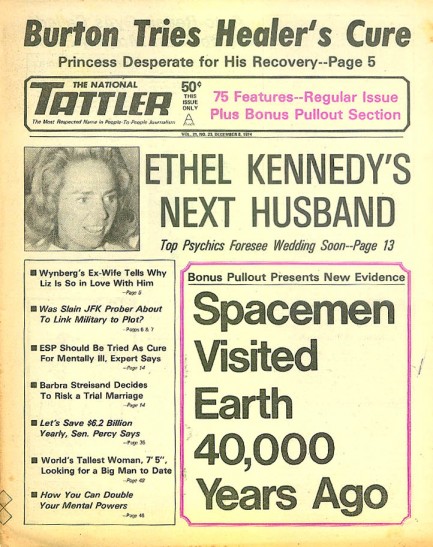
This issue of The National Tattler hit newsstands today in 1974, and as you can see, it lacks a certain something compared to issues of the 1960s. The earlier Tattler featured fantastically exploitative stories conjured from the darkest reaches of the editors' imaginations, while the 1974 version has content that is—amazingly—mostly true. Mostly. We're not sure about Richard Burton turning to a faith healer to help with his drinking problem, and if he did, it didn't work. Alcohol problems plagued him until his death.
The story that really caught our eye is the piece on Barbra Streisand moving in with her hairdresser. That hairdresser was Jon Peters, who, with a major boost from Streisand, became one of the biggest producers in Hollywood. Quite a climb from giving perms. Starting from scratch, knowing literally zero about moviemaking, he soon earned production credits on hits such as Caddyshack, Rainman, Batman, and The Color Purple. But he also made some ludicrous flops—The Bonfire of the Vanities and Who's That Girl come to mind. That's par for the course for producers. Win a few, lose a few.
Along the way Peters became a legendary eccentric, and these days he's almost as well known for being the subject of a Kevin Smith diatribe about everything that is wrong with Hollywood than for his movie work. Smith's take on Peters is one of the funniest Tinseltown insider tales of all time, and we suggest you do yourself a favor and enjoy it in its entirety. Part 1 is here, and Part 2 is here. It may be the best eighteen minutes you've ever spent online, and as bonus it's got spiders in it. 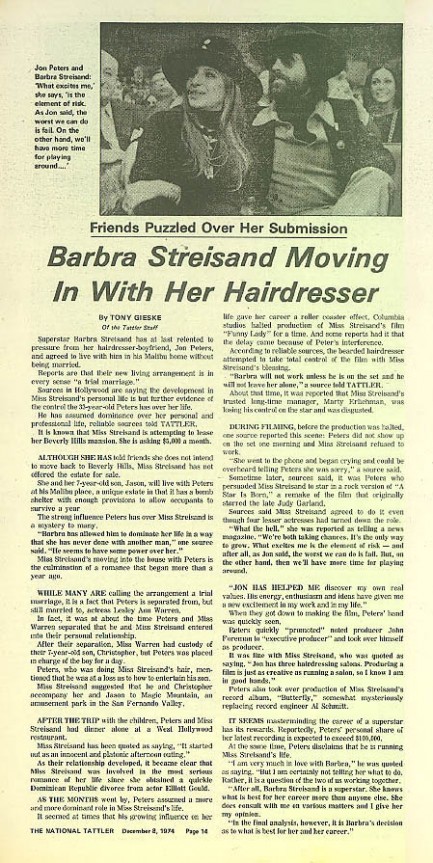 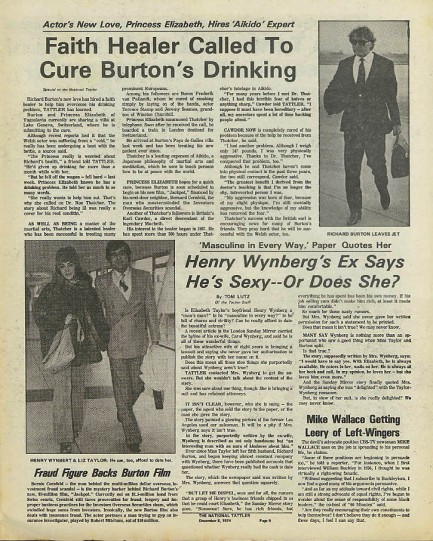
 Fame can be such a drag sometimes. 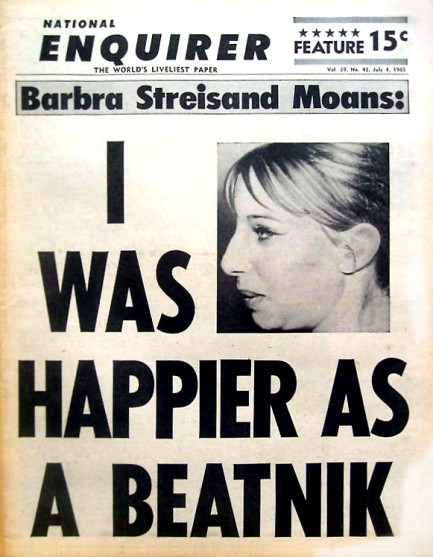
Above, a July 4 1965 issue of National Enquirer with Barbra Streisand on the cover and a lamentation inside on the hollowness of fame and fortune. Streisand was discovered singing in a Greenwich Village gay bar in 1960 and made her first appearance on television the next year on Jack Paar’s show. In 1964 she scored a Broadway hit playing Fanny Brice in the rags to riches musical Funny Girl, and her career took off from there. We don’t know if she ever actually claimed she was happier before her fame. If she did, all we can say is that into everyone’s life some rain must fall. And if that rain happens to be in the form of millions and millions of dollars, well, you just have to deal.
 1970s-era Police Gazette was pretty, colorful and well-designed—but nobody wanted to buy it. 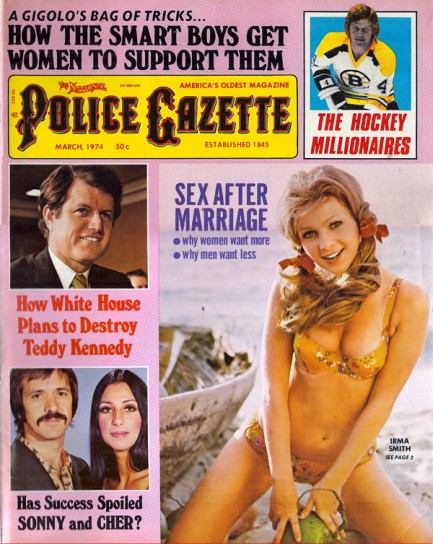 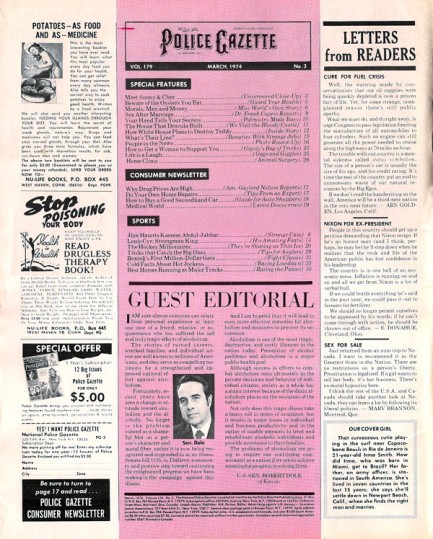 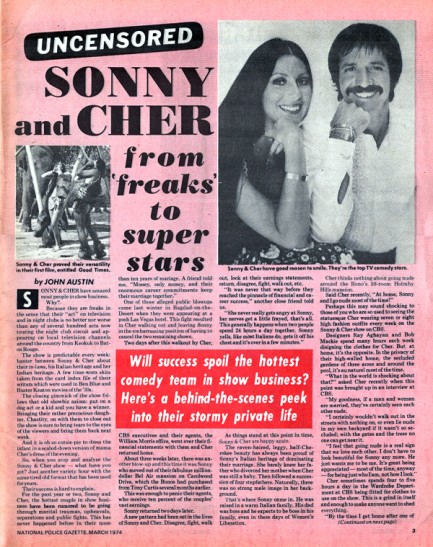  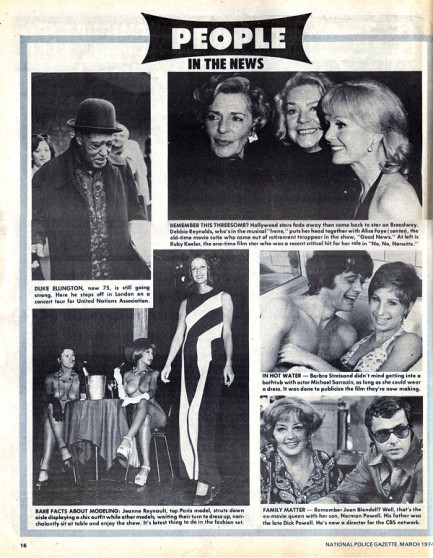 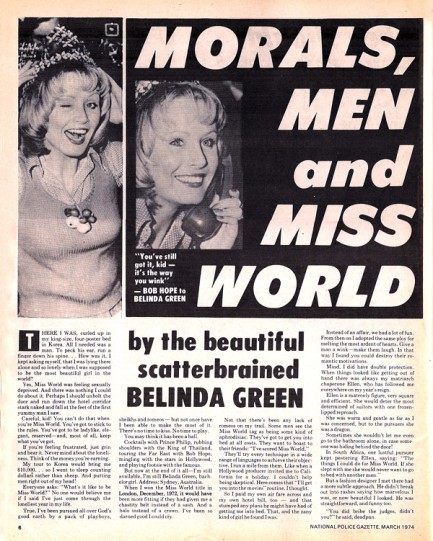 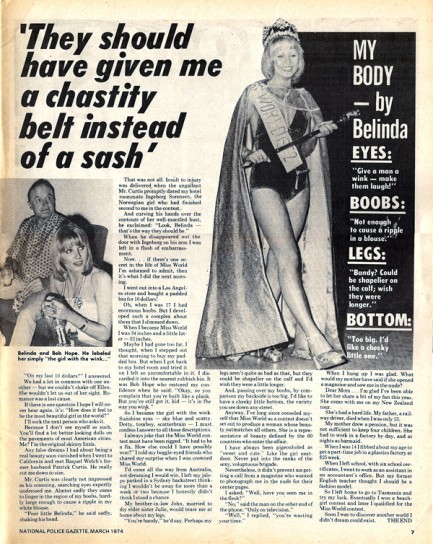 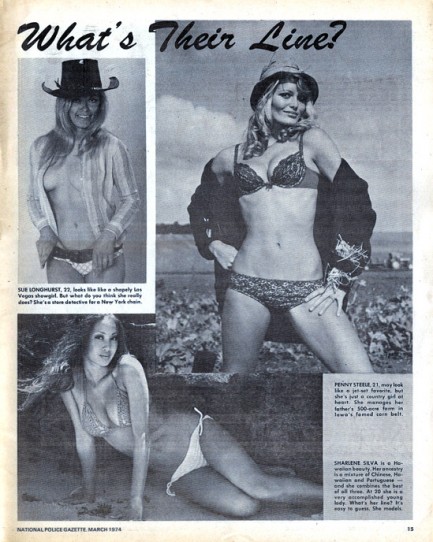
Above are the cover and seven interior pages from a National Police Gazette published in March 1974, two years before the century-old magazine folded. In retrospect it’s easy to see one of the problems the Gazette was having: while the graphics, printing, photo quality and paper stock had all improved over the years, the magazine had lost its visual impact. At the time, editors must have thought they had made the magazine more attractive, but can the above cover really compare to this one, or this one, or this one? Successful competitors like National Enquirer featured little or no color, but the immediacy of their covers was hard to resist. Part of the rationale behind the Gazette’s change may have had to do with its decades-long circulation decline, prompting them to do away with photo-illustrated covers in favor of cheaper promo shots. Or perhaps their longtime cover artisans simply aged and retired, taking their singular talents with them. Or perhaps new editors came aboard and decided to modernize—the default move of managers who have no aesthetic clue. Who knows? We just know that the results speak for themselves. But we’ll keep collecting even these late-period Gazettes because they’re useful in presenting a complete record of the publication. We’re going to go out a limb and say that we now have the largest compendium of Gazette pages on the internet. See them by clicking keywords “Police Gazette” below.
|
 |

The headlines that mattered yesteryear.
2003—Hope Dies
Film legend Bob Hope dies of pneumonia two months after celebrating his 100th birthday. 1945—Churchill Given the Sack
In spite of admiring Winston Churchill as a great wartime leader, Britons elect
Clement Attlee the nation's new prime minister in a sweeping victory for the Labour Party over the Conservatives. 1952—Evita Peron Dies
Eva Duarte de Peron, aka Evita, wife of the president of the Argentine Republic, dies from cancer at age 33. Evita had brought the working classes into a position of political power never witnessed before, but was hated by the nation's powerful military class. She is lain to rest in Milan, Italy in a secret grave under a nun's name, but is eventually returned to Argentina for reburial beside her husband in 1974. 1943—Mussolini Calls It Quits
Italian dictator Benito Mussolini steps down as head of the armed forces and the government. It soon becomes clear that Il Duce did not relinquish power voluntarily, but was forced to resign after former Fascist colleagues turned against him. He is later installed by Germany as leader of the Italian Social Republic in the north of the country, but is killed by partisans in 1945.
|

|
|

It's easy. We have an uploader that makes it a snap. Use it to submit your art, text, header, and subhead. Your post can be funny, serious, or anything in between, as long as it's vintage pulp. You'll get a byline and experience the fleeting pride of free authorship. We'll edit your post for typos, but the rest is up to you. Click here to give us your best shot.

|
|





















































































